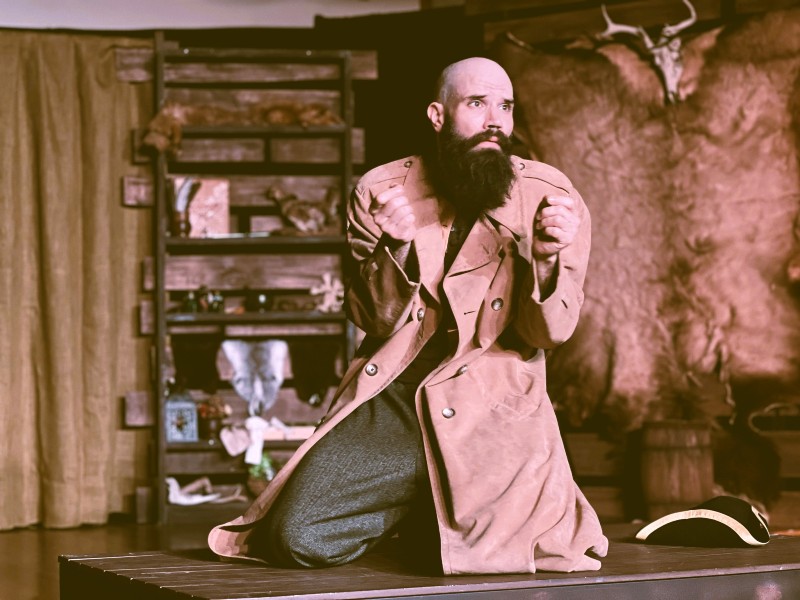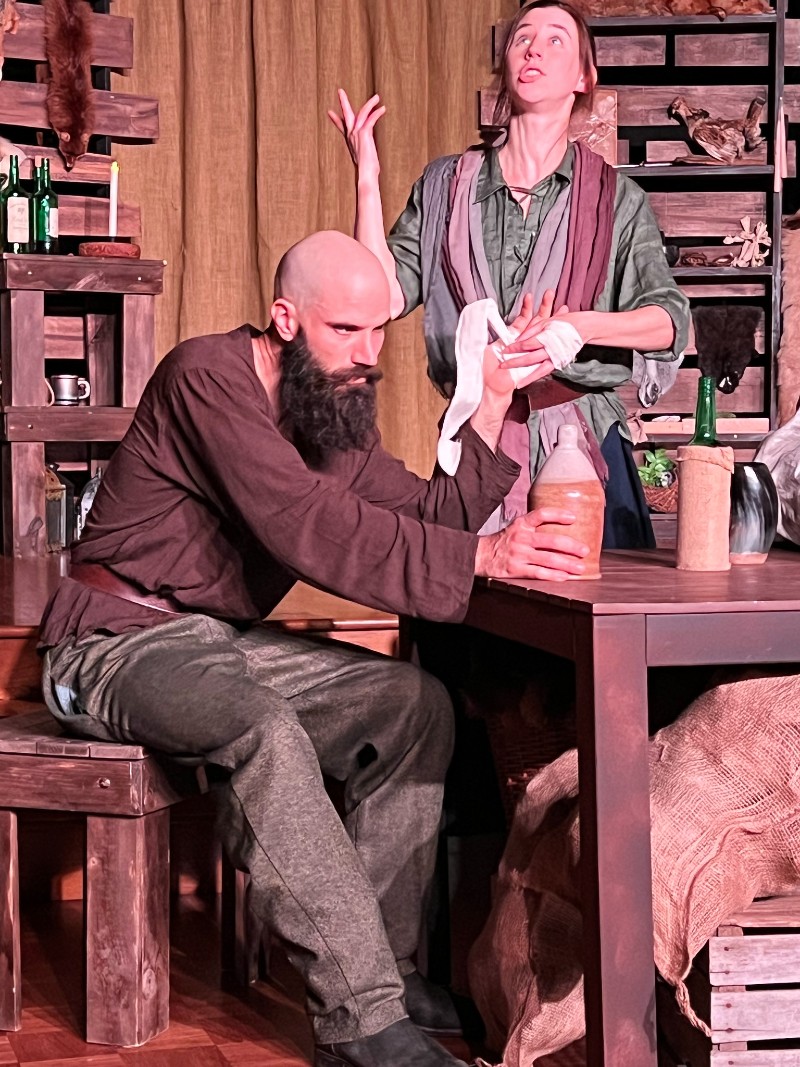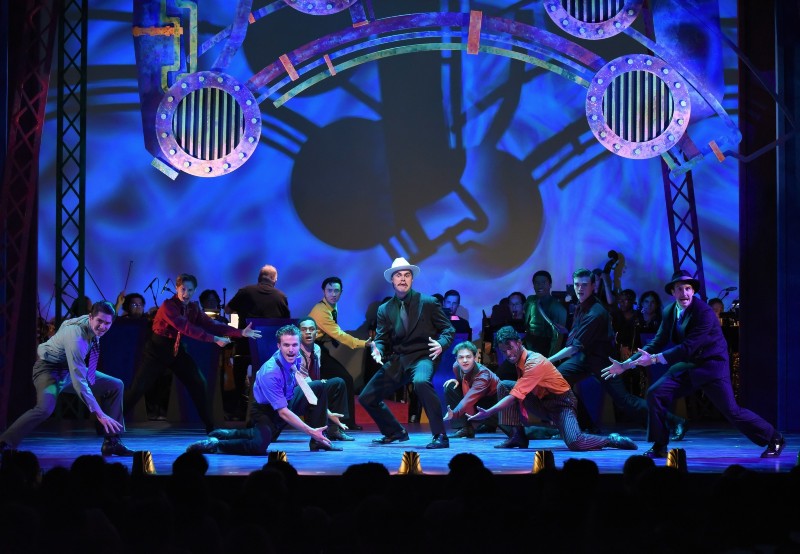Deep in the Woods: "The Man Beast" is haunted, moody, and anxious

’Tis the season for witches and werewolves.
Also—if the Penny Seats Theatre Company’s production of Joseph Zettelmaier’s The Man Beast is any indication—taxidermy, folklore, French accents, and skullduggery.
Set in 1767 France, The Man Beast unfolds in the secluded home of healer and taxidermist Virginie Allard (Brittany Batell), who’s all too aware of her local reputation as “the witch of the woods.” When fellow outcast Jean Chastel (Jonathan Davidson), injured while hunting a legendarily lethal wild beast, barrels his way into the widow’s workshop, Virginie tends to his wounds, and the two form an uneasy alliance.
Yes, the two become lovers, but they also hatch a plan to collect King Louis XVI’s generous bounty for the beast. Jean notes that there have been no deaths in the nearby village since his run-in with it, so, his argument goes, he may well have succeeded in killing the creature. In the absence of more tangible proof, though, he must travel to a far-off menagerie to procure the carcass of a wild, exotic animal, then bring it back to Virginie to prepare it for a dramatic presentation at court.
The pair’s plot succeeds, but as we all know, money can’t buy happiness, and the bond between the two starts to fray.
The Monster Within: Penny Seat’s "The Man Beast" exposes the demons inside us all

On a rainy and ominous Friday night, The Penny Seats Theatre Company launched the fifth installation of its Penny Dreadful series with The Man Beast—a scandalous tale of greed, monsters, lust, and the human connection—at Ann Arbor's Stone Chalet Event Center.
Set in the Gévaudan province of France in 1767, Joseph Zettelmaier's play opens with famed hunter Jean Chastel (played by the brooding Jonathan Davidson) stumbling into a cottage, arm bloodied and clearly in pain. The cabin belongs to Virginie Allard (Brittany Batell), a rumored witch of the woods.
Chastel claims to have been bitten by The Man Beast, a mysterious creature that has murdered over 100 people in the last three years. Virginie cleans his wound, gives him stitches, and tries to convince him to stay for a little while. While they both live secluded in the woods, they rarely cross paths and Virginie admits to being lonely.
Through cups of wine and conversation, we learn that Virginie is a widow and a talented taxidermist. Her cabin is full of animal pelts and her creations, including a bear mounted on the wall.
Sure Bet: University of Michigan's production of "Guys and Dolls" can't miss

Frank Loesser’s "Fugue for Tinhorns" sets the theme for Guys and Dolls with a funny, sweet mingling of voices in search of a winner: “I’ve got the horse right here, his name is Paul Revere, can do, the horse can do.”
It’s all about the bet, on the horse race, the football game and, especially, the game of love, not to overlook the crap game. And here’s a sure bet, audiences will love the University of Michigan’s production of the ever-popular Guys and Dolls, October 6-8 and 12-15 at the Lydia Mendelssohn Theatre.
Guys and Dolls, with music and lyrics by Loesser and book by Abe Burrows and Jo Swerling, brings Damon Runyon’s streetwise tough guys to life with memorable songs, sharp dancing, a unique Broadway language, and the bright lights of the big city.
Tailored Feelings: "Intimate Apparel" sews together the relationships between a Black clothier, her clientele, and romantic interests

Every day we wake up and get dressed. But we rarely think about the people who make our clothing.
Pulitzer Prize-winner Lynn Nottage focuses on the emotional life of a clothier in Intimate Apparel, which the University of Michigan's Department of Theatre and Drama is staging through October 8 at the Arthur Miller Theatre.
Set in New York City in 1905, Intimate Apparel follows the story of Esther, played by Myah Bridgewater, a Black seamstress who is known for her superb sewing skills. Her clientele is wide-ranging, from wealthy white socialites to Black prostitutes, namely her best friend Mayme (Gilayah McIntosh), and she specializes in fine undergarments.
Not only is she talented behind a sewing machine, but Esther is also known for being discreet with her customers and their secrets—specifically Mrs. Van Buren (Bella Detwiler), a rich housewife who is having trouble getting pregnant by her husband and is reminded constantly of her failure to do so.
Spirit Animal: Theatre Nova’s “Mlima’s Tale" explores the costs of human greed

At the start of Theatre Nova’s production of Lynn Nottage’s Mlima’s Tale, the four-person cast enters in a line, stomping and breathing deeply in unison, mimicking the movements of an elephant.
For that’s what Mlima is.
The old Kenyan “big tusker,” named after the Swahili word for “mountain,” lumbers onto the stage, at which point actor Mike Sandusky (who stands in for Mlima’s tusks, and spirit, through the rest of the play) speaks: of listening to the winds, and the love he feels for his mate, his family.
But it’s not long before Mlima—despite living within a preserve in Kenya—is felled by a poacher’s poison arrow. The animal’s enormous tusks simply garner too much money in the underground ivory trade to be resisted.
Yet getting that money, because poaching is illegal, is a fraught process, so Mlima’s physical death is followed by a fairly predictable chain of interactions between corrupt authorities, smugglers, ship captains, shady art-world dealers and creators, and rich collectors who can’t be bothered with origin stories of “how the ivory gets made,” so to speak.
Previous critics have noted that a point of inspiration for Mlima’s Tale, which premiered in New York in 2018, is Arthur Schnitzler’s La Ronde, which chronicles a linked series of sexual encounters across class boundaries. In Nottage’s piece, we follow the tusks, personified by the ever-looming Sandusky, as they change hands and enrich each person who briefly possesses them.
History From the Margins: UMS is bringing Druid Theatre's productions of Sean O’Casey’s "Dublin Trilogy" to the Power Center

“The whole world’s in a terrible state of chassis!”
—Captain Boyle
Juno and the Paycock
In 1916 a large part of the world was in chaos and crisis. World War I was tearing Europe apart, and in Ireland, the leaders of anti-British forces saw an opportunity to rise against a pre-occupied British government and attempt to finally drive the British government from Ireland.
The deadly events of what is remembered as the Easter Rising were the beginning of a violent eight-year period that would in time free Ireland from British rule but at a high cost. Following the Rising, a war of independence began, ending with a treaty to give Ireland Free State status while still bonded to Britain. That treaty led to a civil war pitting defenders of the treaty against those who believed the treaty was a betrayal.
Playwright Sean O’Casey grew up in the tenements of Dublin. He was a self-taught reader, a laborer, a railway worker, and eventually, a writer with a keen ear for the language of his native city. In the 1920s, he created three plays that covered the period from the Easter Rising to the Civil War. Each play centers on the lives of tenement dwellers in the Irish capital who become caught up in the frenzy and frustration of the long-running domestic war. O’Casey’s plays are both comic and tragic as well as deeply humane.
The University Musical Society (UMS) is presenting the Druid Theatre’s production of O’Casey’s Dublin Trilogy, under the direction of Druid founder and artistic director Garry Hynes, October 18-21. The Galway-based theater company is bringing the play to New York City and Ann Arbor only.
Hynes was artistic director for Druid Theatre from 1975 to 1991 and again from 1995 to the present. From 1991 to 1994, she was the artistic director of the famed Abbey Theatre, where many of O’Casey’s plays premiered.
In a telephone interview, Hynes said O’Casey’s trilogy is about the working people of Dublin living in the tenements.
Dress for Success: Costume designer Suzanne Young clothes actors for local, national, and international theater productions

It was 1981 when Suzanne Young, 21, moved to Boston from her native England.
“It was a bit of a culture shock,” she recalls. “Police came to the costume rental shop for Santa costumes. I wasn’t used to seeing people with guns on their hips or to hearing people tell me how much they loved my accent.”
She’s gotten used to this side of the pond, settling with her husband, Larry, in Dixboro, a village just outside Ann Arbor, and became a go-to costume designer for area theaters including the University of Michigan, Purple Rose, Wild Swan, Performance Network, and more.
The Youngs found their way here circuitously, with time spent in Europe and different states. But wherever they went, Suzanne created opportunities to work—from opening a school to teach English to French children to developing a wedding gown company.
Insatiable Appetite: Encore Theatre serves up a delicious “Little Shop of Horrors”

Feed me!
The Encore Musical Theatre Company is serving up a feast of fun, a musical time trip to 1960, and a charming story about an odd plant who develops a taste for human blood.
Little Shop of Horrors is not your typical musical, and it wasn’t your typical horror movie when B-movie master Roger Corman directed the screwball movie that inspired a hilarious and oddly lovable musical.
Little Shop of Horrors opened off-Broadway in 1982, with book and lyrics by Howard Ashman and music by Alan Menken while Ashman also directed. The team went on to help rescue Disney animation with hit songs for The Little Mermaid, Beauty and Beast, and Aladdin. Little Shop won raves off-Broadway and moved to Broadway for more acclaim. That led to another movie, the musical version.
The setting is 1960. A nebbish named Seymour Krelborn is laboring under slave conditions at Mushnick’s Florist at starvation wages and few prospects. He is hopelessly in love with Audrey, who also works at Mushnick’s, and is beginning to feel something for sweet, kind Seymour. But she’s currently going with a sadistic biker/dentist, a deadly combo.
Closet of Secrets: PTD Productions' "Perfect Arrangement" opens the door to address homophobia in 1950s America

Would you be willing to hide who you are in exchange for being more accepted by society? Or would the lies and facade crush you?
Perfect Arrangement, written by Topher Payne and set in the 1950s, follows two married couples that are trying to live the life they want while showing the world the life that is expected and accepted. PTD Productions is staging the play at Riverside Arts Center in Ypsilanti.
Bob Martindale (Gary Lehman) is a government employee who works in a unit to find communist sympathizers hiding within the U.S. government. His wife, Millie (Rebecca Lane), is a homemaker and poetry writer. They are best friends with the couple that lives next door, the Baxters, but everything is not as it seems.
Norma Baxter (Skye Earl) works as Bob’s secretary for the government unit and has to deal with all the accusations and confidential files that come across his desk. Her husband, Jimmy Baxter (Andrew Packard), is a school teacher. Both couples seem happy and in love but we quickly learn that it is all a hoax. Bob and Jimmy are the ones who are together and madly in love, as are Millie and Norma. They have created this elaborate scheme to protect themselves from society’s extreme scrutiny and fear of homosexuality.
It might seem like this arrangement is drastic, but Norma and Bob find themselves in danger at work when they are told to sniff out any employees that could make the government look bad. This includes any “loose women,” deviants, and anyone thought to be a homosexual. Stuck between a rock and a hard place, they must fire their gay coworkers while still pretending not to be like them to keep their own jobs.
Make the Trek: "Return to the Forbidden Planet" reimagines "The Tempest" as a campy sci-fi musical

If you’re drawn to the idea of outdoor theater and goofy jukebox musicals that combine elements of Shakespeare and Star Trek—well, Scotty, the Penny Seats Theatre Company is currently staging a show in Ann Arbor's Burns Park that will likely beam you right up.
Return to the Forbidden Planet, by Bob Carlton, first hit London stages in the 1980s, and the show comically reimagines The Tempest with an assist from pop songs of the ‘50s and ‘60s, as well as the campy sci-fi film classic Forbidden Planet (1956).
Captain Tempest, played by a Shatner-esque Cordell Smith, has just launched with his crew (and the audience, otherwise known as the ship’s “passengers”) when the ship, the Albatross, finds itself in a meteor shower—thus cueing up “Great Balls of Fire,” naturally—and then drawn to the planet D’Illyria. There, a long-marooned father and daughter, Doctor Prospero (Will Myers) and Miranda (Ella Ledbetter-Newton), come aboard, as does their robot assistant, Ariel (Allison Megroet). Prospero tells his back story while pleading/singing “Don’t Let Me Be Misunderstood.”
Soon, a huge, tentacled monster attacks the ship; past relationships come to light; schemes are hatched; a love triangle develops; and a grand sacrifice is made—conveyed via cardboard cutouts on sticks, in a kind of whimsical puppet show.


































